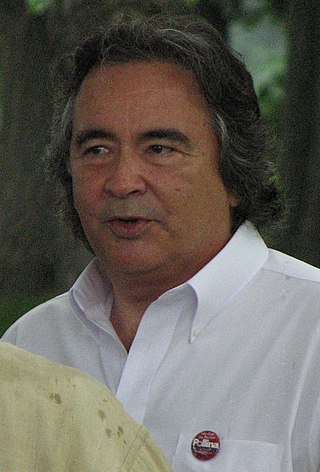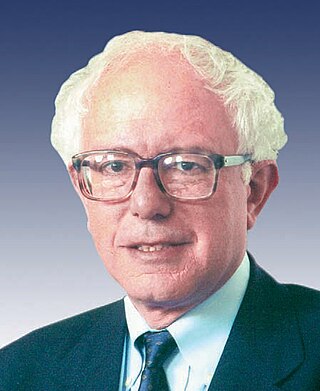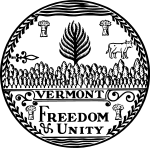
Robert Theodore Stafford was an American politician from Vermont. In his lengthy political career, he served as the 71st governor of Vermont, a United States representative, and a U.S. Senator. A Republican, Stafford was generally considered a liberal, or "Rockefeller Republican".

The 2006 United States Senate election in Vermont was held November 7, 2006. Incumbent independent Senator Jim Jeffords decided to retire rather than seek reelection to a fourth term, and Bernie Sanders was elected to succeed him.
Diane B. Snelling is an American politician from Vermont who served as a Republican member of the Vermont Senate, representing Chittenden County. Snelling was first appointed to the Vermont State Senate in January 2002 by Governor Howard Dean to serve the remainder of her mother, Barbara Snelling's, term in office, after her mother retired from the Senate.

The 2006 United States House of Representatives election in Vermont was held on November 7, 2006, for representation of Vermont's at-large congressional district in the United States House of Representatives from January 3, 2007, to January 3, 2009.

United States gubernatorial elections were held on November 7, 2000, in 11 states and two territories. The elections coincided with the presidential election. Democrats gained one seat by defeating an incumbent in West Virginia. As of 2024, this remains the last gubernatorial cycle in which a Democrat won in Indiana.

Anthony Pollina is an American politician who has served as Chair of the Vermont Progressive Party since 2017, and was as a member of the Vermont Senate from 2011 to 2023.

The 2010 Vermont gubernatorial general election took place on November 2. Vermont and New Hampshire are the only two states where the governor serves a two-year term instead of four. Primary elections took place on August 24.

The 2000 United States Senate election in Vermont took place on November 7, 2000. Incumbent Republican U.S. Senator Jim Jeffords won re-election to a third term in office. In May 2001, Jeffords left the Republican Party and announced that he would become an independent who would caucus with the Democratic Party. His party exit broke the 50–50 lock in the Senate and effectively gave the Democrats the majority. Thus, that switch marked the first time since 1855 that Vermont had no Republicans in its entire congressional delegation.

The 2012 Vermont gubernatorial election took place on November 6, 2012, to elect the Governor of Vermont. Incumbent Democratic Governor Peter Shumlin won re-election to a second term, making this the only one of his gubernatorial elections in which he won a majority of the vote. In his 2010 and 2014 races, the Vermont General Assembly was required to choose a winner in accordance with the state constitution, because no candidate won a majority.

Vermont's 2012 general elections were held on November 6, 2012. Primary elections were held on August 28, 2012.

The 2014 Vermont gubernatorial election took place on November 4, 2014, to elect the governor of Vermont, concurrently with elections to the United States Senate in other states and elections to the United States House of Representatives and various state and local elections. Incumbent Democratic governor Peter Shumlin ran for reelection to a third term in office against Republican businessman Scott Milne, Libertarian businessman Dan Feliciano and several other minor party and independent candidates.
Ruth Dwyer is an American political figure who was the unsuccessful Republican nominee for Governor in 1998 and 2000.

The 2016 Vermont gubernatorial election took place on November 8, 2016, and elected the governor of Vermont, concurrently with the 2016 U.S. presidential election, as well as elections to the United States Senate in other states and elections to the United States House of Representatives and various state and local elections. Incumbent Democratic governor Peter Shumlin was eligible to run for re-election to a fourth term in office, but opted to retire instead.

The 2002 Vermont gubernatorial election took place on November 5, 2002. Incumbent Democratic Governor Howard Dean did not run for re-election to a sixth full term as Governor of Vermont. Republican Jim Douglas defeated Democratic candidate Doug Racine and independent candidate Cornelius Hogan, among others, to succeed him. Since no candidate received a majority in the popular vote, Douglas was elected by the Vermont General Assembly per the state constitution.

The 1992 United States House of Representatives election in Vermont was held on Tuesday, November 3, 1992, to elect the U.S. representative from the state's at-large congressional district. The election coincided with the elections of other federal and state offices, including a quadrennial presidential election and an election to the U.S. Senate.

The 1996 United States House of Representatives election in Vermont was held on Tuesday, November 5, 1996, to elect the U.S. representative from the state's at-large congressional district. The election coincided with the elections of other federal and state offices, including a quadrennial presidential election.

The 2002 United States House of Representatives election in Vermont was held on Tuesday, November 5, 2002, to elect the U.S. representative from the state's at-large congressional district. The election coincided with the elections of other federal and state offices.

The 2020 Vermont gubernatorial election was held on November 3, 2020, to elect the governor of Vermont. As Vermont does not impose term limits upon its governors, incumbent Republican governor Phil Scott was eligible to run for re-election to a third two-year term in office. On November 18, 2019, he confirmed that he was running for reelection, but did not yet publicly announce his campaign. On May 28, 2020, he officially announced his candidacy but stated that he would not campaign, maintain a campaign staff, or fundraise because of the state of emergency due to the COVID-19 pandemic in Vermont. The primary was held on August 11. Scott won re-election to a third term in a landslide, defeating Progressive and Democratic nominee, Lieutenant Governor David Zuckerman.

The 2022 Vermont Senate election took place on November 8, 2022, as part of the biennial United States elections. The election coincided with elections for other offices including the U.S. Senate, U.S. House, Governor, and State House. Vermont voters elected all 30 state senators from 16 districts, with each district electing between one and three senators. State senators serve two-year terms in the Vermont Senate. Primary elections were held on August 9, 2022. This election would be the first to use new districts adopted by the Vermont General Assembly to allocate for population changes across the state after the 2020 census.






















